Civil Engineering: Waterproofing Admixtures Literature Review Analysis
VerifiedAdded on 2022/10/18
|12
|2491
|10
Report
AI Summary
This literature review examines the critical role of waterproofing in concrete structures, particularly in water-retaining facilities like tanks, and the need for effective solutions to prevent water damage and leakage. The report focuses on comparing cementitious and crystalline admixtures, the two primary waterproofing materials. It explores the problem statement, which highlights the lack of sufficient documentation on the variability in performance of these admixtures, which can hinder optimal material selection. The study aims to compare the waterproofing capabilities, flexural and compressive strengths of concrete/mortar, and setting times of mortar when these admixtures are used. The review defines waterproofing and its systems, including liquid membranes and sheet membranes, and their advantages and disadvantages. It also delves into the chemical differences, advantages, and applications of both cementitious and crystalline admixtures, discussing how the proper selection of waterproofing materials can enhance the longevity and integrity of structures by countering hydrostatic pressure, resisting harmful chemicals, and sealing concrete pores. The research justifies the need for a comparative assessment to identify more cost-effective and efficient waterproofing solutions, ultimately contributing to the conservation and stability of water-retaining structures.

LITERATURE REVIEW 1
COMPARATIVE ANALYSIS OF CEMENTITIOUS AND CRYSTALLINE ADMIXTURES
USED IN WATERPROOFING STRUCTURES UNDER HYDRO STATIC PRESSURE
By (Firstname Lastname)
Civil Engineering Project Dissertation
Name of Professor
Name of Institution
September 21, 2019
COMPARATIVE ANALYSIS OF CEMENTITIOUS AND CRYSTALLINE ADMIXTURES
USED IN WATERPROOFING STRUCTURES UNDER HYDRO STATIC PRESSURE
By (Firstname Lastname)
Civil Engineering Project Dissertation
Name of Professor
Name of Institution
September 21, 2019
Paraphrase This Document
Need a fresh take? Get an instant paraphrase of this document with our AI Paraphraser
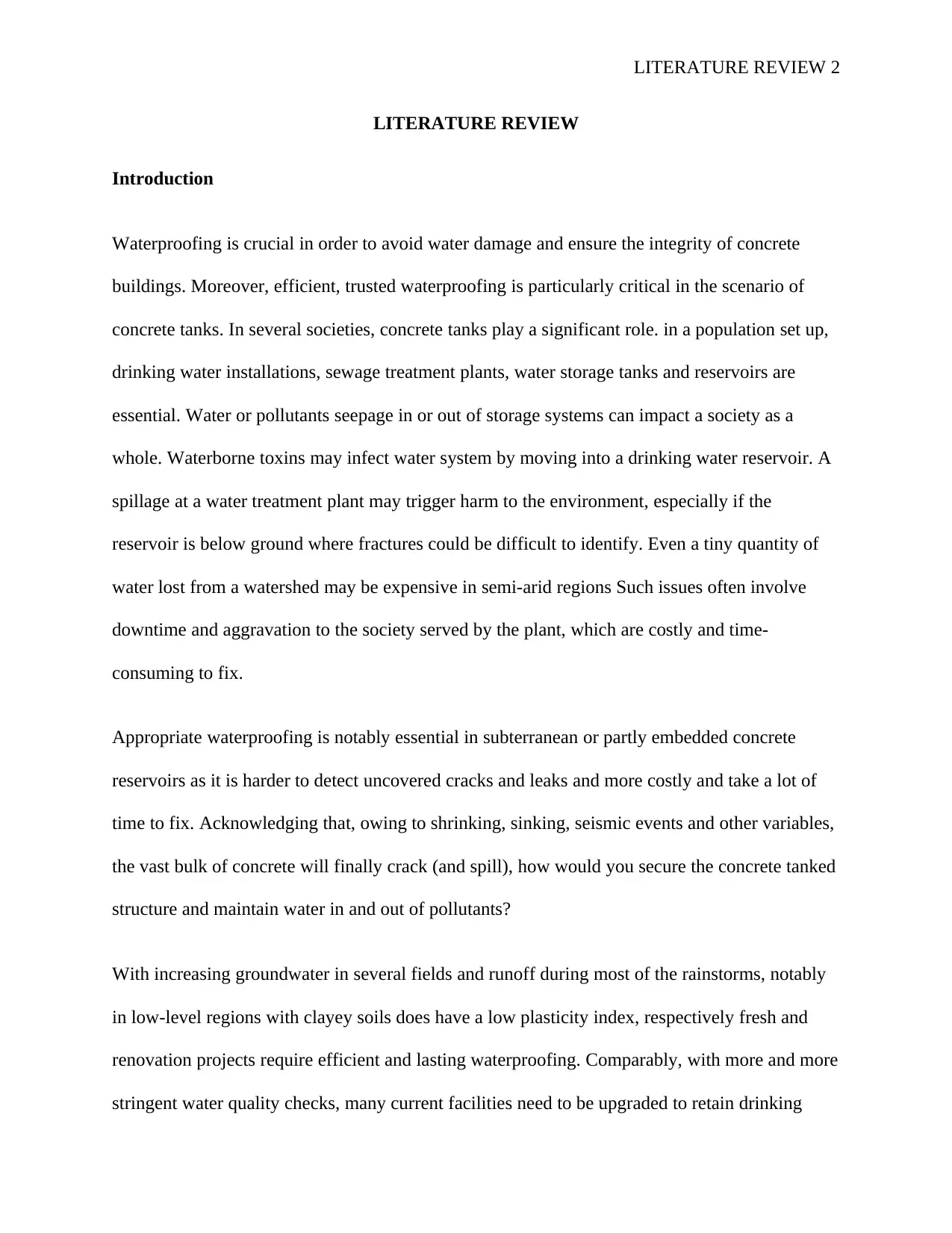
LITERATURE REVIEW 2
LITERATURE REVIEW
Introduction
Waterproofing is crucial in order to avoid water damage and ensure the integrity of concrete
buildings. Moreover, efficient, trusted waterproofing is particularly critical in the scenario of
concrete tanks. In several societies, concrete tanks play a significant role. in a population set up,
drinking water installations, sewage treatment plants, water storage tanks and reservoirs are
essential. Water or pollutants seepage in or out of storage systems can impact a society as a
whole. Waterborne toxins may infect water system by moving into a drinking water reservoir. A
spillage at a water treatment plant may trigger harm to the environment, especially if the
reservoir is below ground where fractures could be difficult to identify. Even a tiny quantity of
water lost from a watershed may be expensive in semi-arid regions Such issues often involve
downtime and aggravation to the society served by the plant, which are costly and time-
consuming to fix.
Appropriate waterproofing is notably essential in subterranean or partly embedded concrete
reservoirs as it is harder to detect uncovered cracks and leaks and more costly and take a lot of
time to fix. Acknowledging that, owing to shrinking, sinking, seismic events and other variables,
the vast bulk of concrete will finally crack (and spill), how would you secure the concrete tanked
structure and maintain water in and out of pollutants?
With increasing groundwater in several fields and runoff during most of the rainstorms, notably
in low-level regions with clayey soils does have a low plasticity index, respectively fresh and
renovation projects require efficient and lasting waterproofing. Comparably, with more and more
stringent water quality checks, many current facilities need to be upgraded to retain drinking
LITERATURE REVIEW
Introduction
Waterproofing is crucial in order to avoid water damage and ensure the integrity of concrete
buildings. Moreover, efficient, trusted waterproofing is particularly critical in the scenario of
concrete tanks. In several societies, concrete tanks play a significant role. in a population set up,
drinking water installations, sewage treatment plants, water storage tanks and reservoirs are
essential. Water or pollutants seepage in or out of storage systems can impact a society as a
whole. Waterborne toxins may infect water system by moving into a drinking water reservoir. A
spillage at a water treatment plant may trigger harm to the environment, especially if the
reservoir is below ground where fractures could be difficult to identify. Even a tiny quantity of
water lost from a watershed may be expensive in semi-arid regions Such issues often involve
downtime and aggravation to the society served by the plant, which are costly and time-
consuming to fix.
Appropriate waterproofing is notably essential in subterranean or partly embedded concrete
reservoirs as it is harder to detect uncovered cracks and leaks and more costly and take a lot of
time to fix. Acknowledging that, owing to shrinking, sinking, seismic events and other variables,
the vast bulk of concrete will finally crack (and spill), how would you secure the concrete tanked
structure and maintain water in and out of pollutants?
With increasing groundwater in several fields and runoff during most of the rainstorms, notably
in low-level regions with clayey soils does have a low plasticity index, respectively fresh and
renovation projects require efficient and lasting waterproofing. Comparably, with more and more
stringent water quality checks, many current facilities need to be upgraded to retain drinking
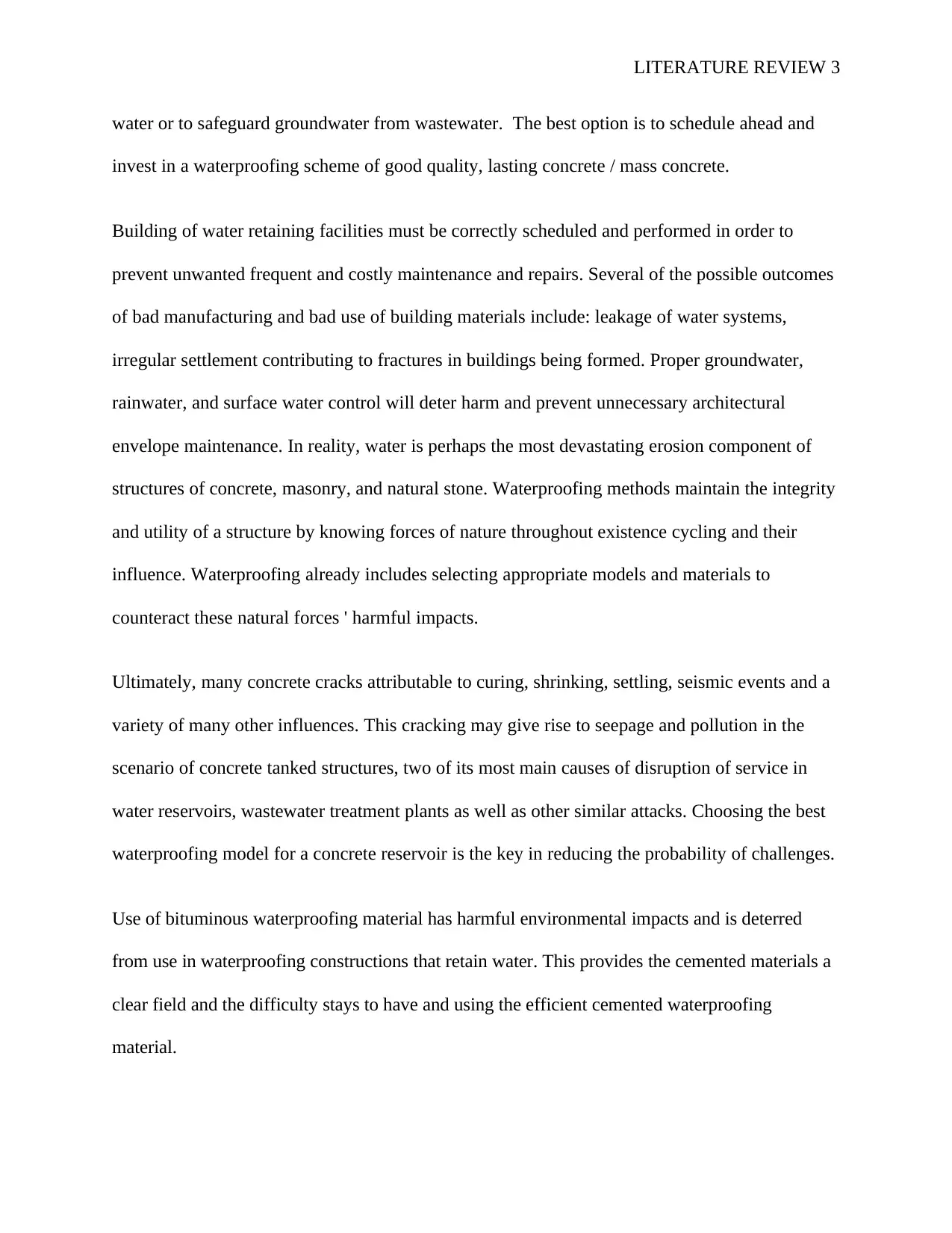
LITERATURE REVIEW 3
water or to safeguard groundwater from wastewater. The best option is to schedule ahead and
invest in a waterproofing scheme of good quality, lasting concrete / mass concrete.
Building of water retaining facilities must be correctly scheduled and performed in order to
prevent unwanted frequent and costly maintenance and repairs. Several of the possible outcomes
of bad manufacturing and bad use of building materials include: leakage of water systems,
irregular settlement contributing to fractures in buildings being formed. Proper groundwater,
rainwater, and surface water control will deter harm and prevent unnecessary architectural
envelope maintenance. In reality, water is perhaps the most devastating erosion component of
structures of concrete, masonry, and natural stone. Waterproofing methods maintain the integrity
and utility of a structure by knowing forces of nature throughout existence cycling and their
influence. Waterproofing already includes selecting appropriate models and materials to
counteract these natural forces ' harmful impacts.
Ultimately, many concrete cracks attributable to curing, shrinking, settling, seismic events and a
variety of many other influences. This cracking may give rise to seepage and pollution in the
scenario of concrete tanked structures, two of its most main causes of disruption of service in
water reservoirs, wastewater treatment plants as well as other similar attacks. Choosing the best
waterproofing model for a concrete reservoir is the key in reducing the probability of challenges.
Use of bituminous waterproofing material has harmful environmental impacts and is deterred
from use in waterproofing constructions that retain water. This provides the cemented materials a
clear field and the difficulty stays to have and using the efficient cemented waterproofing
material.
water or to safeguard groundwater from wastewater. The best option is to schedule ahead and
invest in a waterproofing scheme of good quality, lasting concrete / mass concrete.
Building of water retaining facilities must be correctly scheduled and performed in order to
prevent unwanted frequent and costly maintenance and repairs. Several of the possible outcomes
of bad manufacturing and bad use of building materials include: leakage of water systems,
irregular settlement contributing to fractures in buildings being formed. Proper groundwater,
rainwater, and surface water control will deter harm and prevent unnecessary architectural
envelope maintenance. In reality, water is perhaps the most devastating erosion component of
structures of concrete, masonry, and natural stone. Waterproofing methods maintain the integrity
and utility of a structure by knowing forces of nature throughout existence cycling and their
influence. Waterproofing already includes selecting appropriate models and materials to
counteract these natural forces ' harmful impacts.
Ultimately, many concrete cracks attributable to curing, shrinking, settling, seismic events and a
variety of many other influences. This cracking may give rise to seepage and pollution in the
scenario of concrete tanked structures, two of its most main causes of disruption of service in
water reservoirs, wastewater treatment plants as well as other similar attacks. Choosing the best
waterproofing model for a concrete reservoir is the key in reducing the probability of challenges.
Use of bituminous waterproofing material has harmful environmental impacts and is deterred
from use in waterproofing constructions that retain water. This provides the cemented materials a
clear field and the difficulty stays to have and using the efficient cemented waterproofing
material.
⊘ This is a preview!⊘
Do you want full access?
Subscribe today to unlock all pages.

Trusted by 1+ million students worldwide

LITERATURE REVIEW 4
Problem Statement
The most pertinent waterproofing items in water holding systems are crystalline and cemented
admixtures. They have different behavior with respect to waterproofing capability and their
impacts on concrete characteristics. Nevertheless, there seems to be no documentary evidence on
this variability thus it would be important to make rational decisions on which waterproofing
products to use under different situations in order to find a cheaper and more efficient alternative
to replace traditional waterproofing material that ensures the structure's conservation and
prosperity. Consequently, this research would strive to make comparisons on the waterproofing
features and impacts on concrete / mortar characteristics.
Study Justification
Leakage issues found in constructions that stores water are a threat to several individuals. The
issue could be either due to bad craftsmanship, bad building material performance, or eventually
absence of adequate insight into the right waterproofing admixture to be used. Many
waterproofing materials cannot provide maximum effectiveness contributing to unexpected
increases in repair and maintenance expenditure. A waterproofing material or a combination of
waterproofing materials that can enhance a water retaining structure's life span and everything
that can be a better choice is required to eradicate this additional cost and offer a comfort to the
customer / user.
When choosing or clarifying these products, care must be taken because their producers are not
testing the same characteristics. When the producers check the same characteristics, they cannot
use the same techniques of testing. This absence of standardized testing makes it very hard to
match the manufacturers ' output information. As a consequence, product choice is subjectively
Problem Statement
The most pertinent waterproofing items in water holding systems are crystalline and cemented
admixtures. They have different behavior with respect to waterproofing capability and their
impacts on concrete characteristics. Nevertheless, there seems to be no documentary evidence on
this variability thus it would be important to make rational decisions on which waterproofing
products to use under different situations in order to find a cheaper and more efficient alternative
to replace traditional waterproofing material that ensures the structure's conservation and
prosperity. Consequently, this research would strive to make comparisons on the waterproofing
features and impacts on concrete / mortar characteristics.
Study Justification
Leakage issues found in constructions that stores water are a threat to several individuals. The
issue could be either due to bad craftsmanship, bad building material performance, or eventually
absence of adequate insight into the right waterproofing admixture to be used. Many
waterproofing materials cannot provide maximum effectiveness contributing to unexpected
increases in repair and maintenance expenditure. A waterproofing material or a combination of
waterproofing materials that can enhance a water retaining structure's life span and everything
that can be a better choice is required to eradicate this additional cost and offer a comfort to the
customer / user.
When choosing or clarifying these products, care must be taken because their producers are not
testing the same characteristics. When the producers check the same characteristics, they cannot
use the same techniques of testing. This absence of standardized testing makes it very hard to
match the manufacturers ' output information. As a consequence, product choice is subjectively
Paraphrase This Document
Need a fresh take? Get an instant paraphrase of this document with our AI Paraphraser
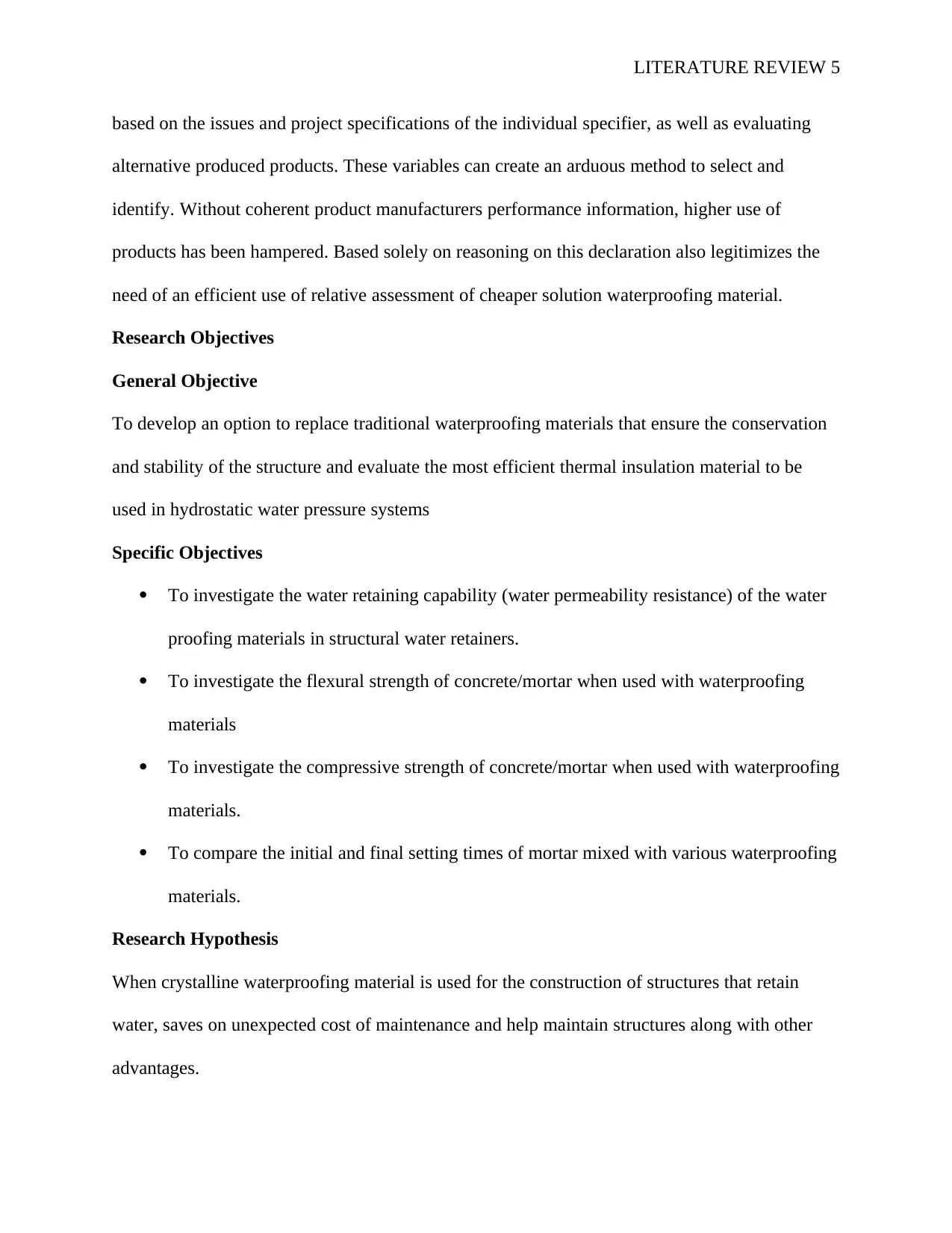
LITERATURE REVIEW 5
based on the issues and project specifications of the individual specifier, as well as evaluating
alternative produced products. These variables can create an arduous method to select and
identify. Without coherent product manufacturers performance information, higher use of
products has been hampered. Based solely on reasoning on this declaration also legitimizes the
need of an efficient use of relative assessment of cheaper solution waterproofing material.
Research Objectives
General Objective
To develop an option to replace traditional waterproofing materials that ensure the conservation
and stability of the structure and evaluate the most efficient thermal insulation material to be
used in hydrostatic water pressure systems
Specific Objectives
To investigate the water retaining capability (water permeability resistance) of the water
proofing materials in structural water retainers.
To investigate the flexural strength of concrete/mortar when used with waterproofing
materials
To investigate the compressive strength of concrete/mortar when used with waterproofing
materials.
To compare the initial and final setting times of mortar mixed with various waterproofing
materials.
Research Hypothesis
When crystalline waterproofing material is used for the construction of structures that retain
water, saves on unexpected cost of maintenance and help maintain structures along with other
advantages.
based on the issues and project specifications of the individual specifier, as well as evaluating
alternative produced products. These variables can create an arduous method to select and
identify. Without coherent product manufacturers performance information, higher use of
products has been hampered. Based solely on reasoning on this declaration also legitimizes the
need of an efficient use of relative assessment of cheaper solution waterproofing material.
Research Objectives
General Objective
To develop an option to replace traditional waterproofing materials that ensure the conservation
and stability of the structure and evaluate the most efficient thermal insulation material to be
used in hydrostatic water pressure systems
Specific Objectives
To investigate the water retaining capability (water permeability resistance) of the water
proofing materials in structural water retainers.
To investigate the flexural strength of concrete/mortar when used with waterproofing
materials
To investigate the compressive strength of concrete/mortar when used with waterproofing
materials.
To compare the initial and final setting times of mortar mixed with various waterproofing
materials.
Research Hypothesis
When crystalline waterproofing material is used for the construction of structures that retain
water, saves on unexpected cost of maintenance and help maintain structures along with other
advantages.
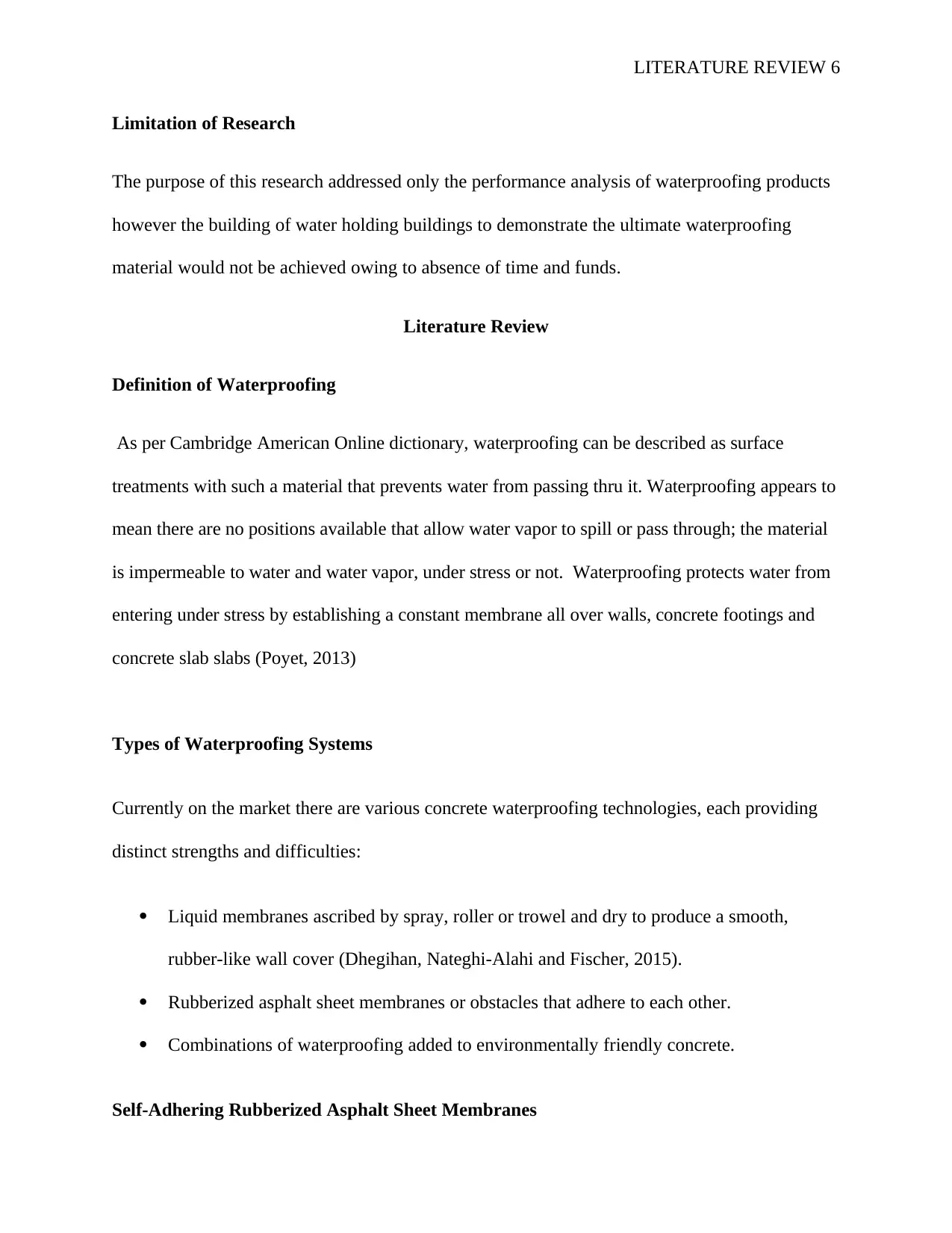
LITERATURE REVIEW 6
Limitation of Research
The purpose of this research addressed only the performance analysis of waterproofing products
however the building of water holding buildings to demonstrate the ultimate waterproofing
material would not be achieved owing to absence of time and funds.
Literature Review
Definition of Waterproofing
As per Cambridge American Online dictionary, waterproofing can be described as surface
treatments with such a material that prevents water from passing thru it. Waterproofing appears to
mean there are no positions available that allow water vapor to spill or pass through; the material
is impermeable to water and water vapor, under stress or not. Waterproofing protects water from
entering under stress by establishing a constant membrane all over walls, concrete footings and
concrete slab slabs (Poyet, 2013)
Types of Waterproofing Systems
Currently on the market there are various concrete waterproofing technologies, each providing
distinct strengths and difficulties:
Liquid membranes ascribed by spray, roller or trowel and dry to produce a smooth,
rubber-like wall cover (Dhegihan, Nateghi-Alahi and Fischer, 2015).
Rubberized asphalt sheet membranes or obstacles that adhere to each other.
Combinations of waterproofing added to environmentally friendly concrete.
Self-Adhering Rubberized Asphalt Sheet Membranes
Limitation of Research
The purpose of this research addressed only the performance analysis of waterproofing products
however the building of water holding buildings to demonstrate the ultimate waterproofing
material would not be achieved owing to absence of time and funds.
Literature Review
Definition of Waterproofing
As per Cambridge American Online dictionary, waterproofing can be described as surface
treatments with such a material that prevents water from passing thru it. Waterproofing appears to
mean there are no positions available that allow water vapor to spill or pass through; the material
is impermeable to water and water vapor, under stress or not. Waterproofing protects water from
entering under stress by establishing a constant membrane all over walls, concrete footings and
concrete slab slabs (Poyet, 2013)
Types of Waterproofing Systems
Currently on the market there are various concrete waterproofing technologies, each providing
distinct strengths and difficulties:
Liquid membranes ascribed by spray, roller or trowel and dry to produce a smooth,
rubber-like wall cover (Dhegihan, Nateghi-Alahi and Fischer, 2015).
Rubberized asphalt sheet membranes or obstacles that adhere to each other.
Combinations of waterproofing added to environmentally friendly concrete.
Self-Adhering Rubberized Asphalt Sheet Membranes
⊘ This is a preview!⊘
Do you want full access?
Subscribe today to unlock all pages.

Trusted by 1+ million students worldwide
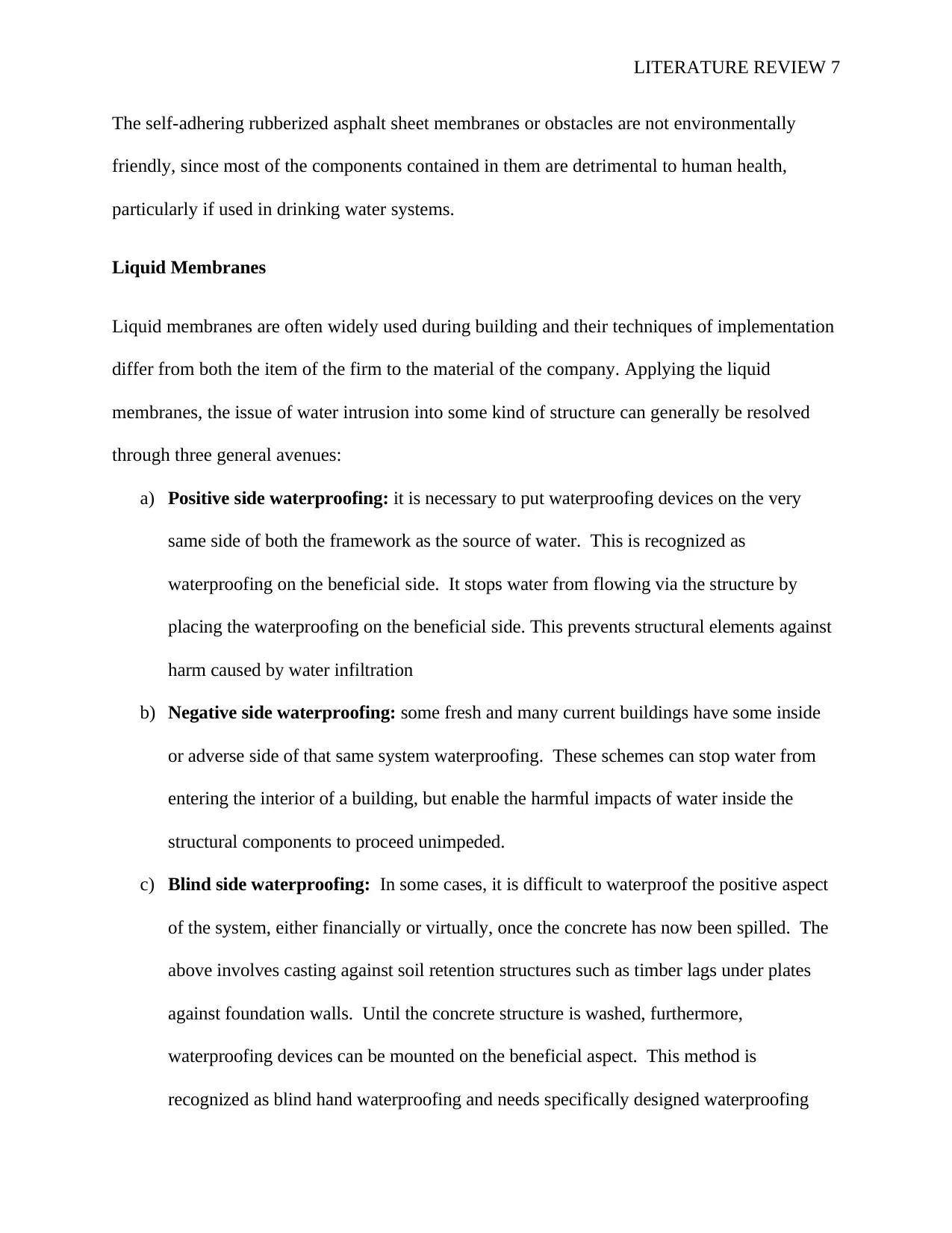
LITERATURE REVIEW 7
The self-adhering rubberized asphalt sheet membranes or obstacles are not environmentally
friendly, since most of the components contained in them are detrimental to human health,
particularly if used in drinking water systems.
Liquid Membranes
Liquid membranes are often widely used during building and their techniques of implementation
differ from both the item of the firm to the material of the company. Applying the liquid
membranes, the issue of water intrusion into some kind of structure can generally be resolved
through three general avenues:
a) Positive side waterproofing: it is necessary to put waterproofing devices on the very
same side of both the framework as the source of water. This is recognized as
waterproofing on the beneficial side. It stops water from flowing via the structure by
placing the waterproofing on the beneficial side. This prevents structural elements against
harm caused by water infiltration
b) Negative side waterproofing: some fresh and many current buildings have some inside
or adverse side of that same system waterproofing. These schemes can stop water from
entering the interior of a building, but enable the harmful impacts of water inside the
structural components to proceed unimpeded.
c) Blind side waterproofing: In some cases, it is difficult to waterproof the positive aspect
of the system, either financially or virtually, once the concrete has now been spilled. The
above involves casting against soil retention structures such as timber lags under plates
against foundation walls. Until the concrete structure is washed, furthermore,
waterproofing devices can be mounted on the beneficial aspect. This method is
recognized as blind hand waterproofing and needs specifically designed waterproofing
The self-adhering rubberized asphalt sheet membranes or obstacles are not environmentally
friendly, since most of the components contained in them are detrimental to human health,
particularly if used in drinking water systems.
Liquid Membranes
Liquid membranes are often widely used during building and their techniques of implementation
differ from both the item of the firm to the material of the company. Applying the liquid
membranes, the issue of water intrusion into some kind of structure can generally be resolved
through three general avenues:
a) Positive side waterproofing: it is necessary to put waterproofing devices on the very
same side of both the framework as the source of water. This is recognized as
waterproofing on the beneficial side. It stops water from flowing via the structure by
placing the waterproofing on the beneficial side. This prevents structural elements against
harm caused by water infiltration
b) Negative side waterproofing: some fresh and many current buildings have some inside
or adverse side of that same system waterproofing. These schemes can stop water from
entering the interior of a building, but enable the harmful impacts of water inside the
structural components to proceed unimpeded.
c) Blind side waterproofing: In some cases, it is difficult to waterproof the positive aspect
of the system, either financially or virtually, once the concrete has now been spilled. The
above involves casting against soil retention structures such as timber lags under plates
against foundation walls. Until the concrete structure is washed, furthermore,
waterproofing devices can be mounted on the beneficial aspect. This method is
recognized as blind hand waterproofing and needs specifically designed waterproofing
Paraphrase This Document
Need a fresh take? Get an instant paraphrase of this document with our AI Paraphraser
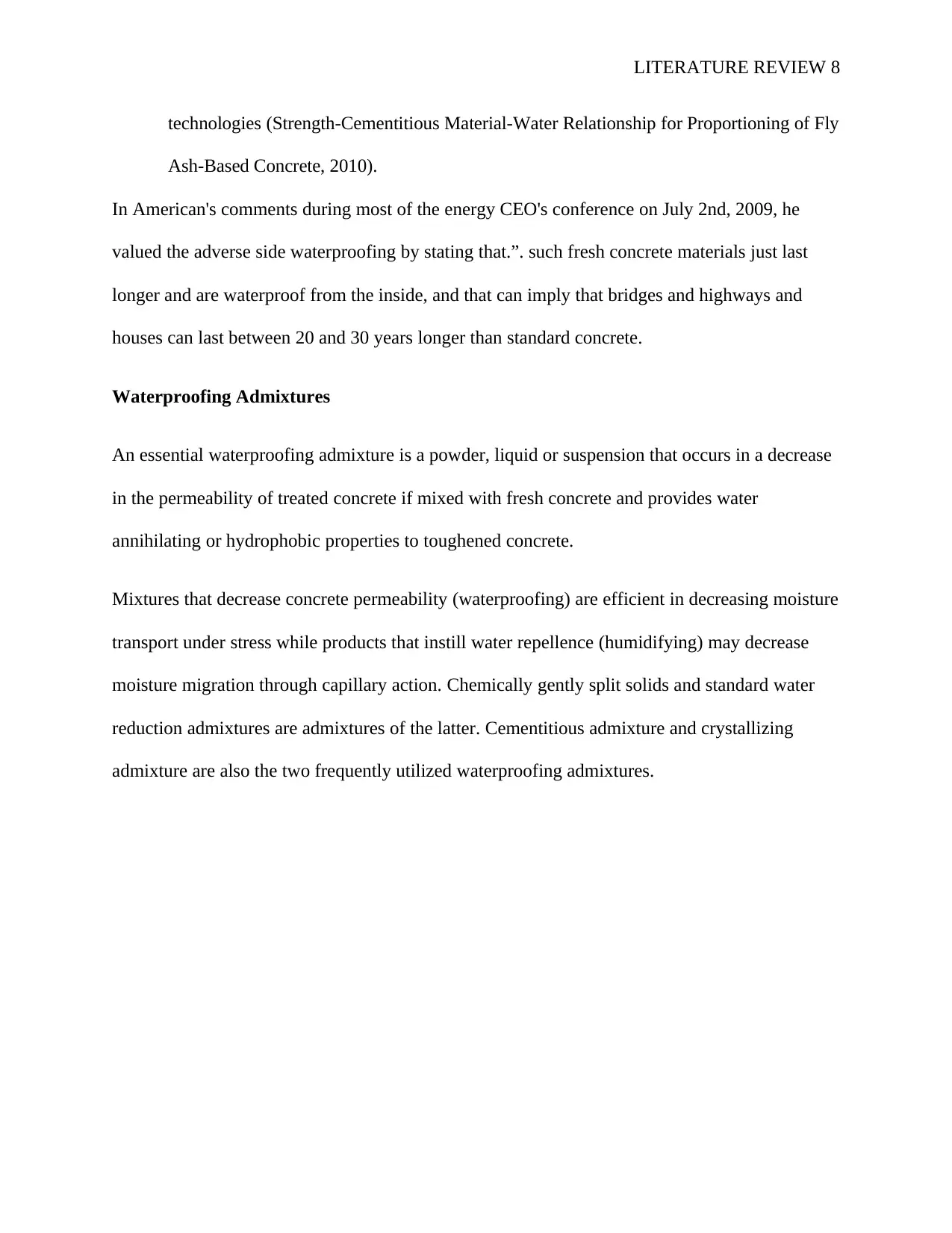
LITERATURE REVIEW 8
technologies (Strength-Cementitious Material-Water Relationship for Proportioning of Fly
Ash-Based Concrete, 2010).
In American's comments during most of the energy CEO's conference on July 2nd, 2009, he
valued the adverse side waterproofing by stating that.”. such fresh concrete materials just last
longer and are waterproof from the inside, and that can imply that bridges and highways and
houses can last between 20 and 30 years longer than standard concrete.
Waterproofing Admixtures
An essential waterproofing admixture is a powder, liquid or suspension that occurs in a decrease
in the permeability of treated concrete if mixed with fresh concrete and provides water
annihilating or hydrophobic properties to toughened concrete.
Mixtures that decrease concrete permeability (waterproofing) are efficient in decreasing moisture
transport under stress while products that instill water repellence (humidifying) may decrease
moisture migration through capillary action. Chemically gently split solids and standard water
reduction admixtures are admixtures of the latter. Cementitious admixture and crystallizing
admixture are also the two frequently utilized waterproofing admixtures.
technologies (Strength-Cementitious Material-Water Relationship for Proportioning of Fly
Ash-Based Concrete, 2010).
In American's comments during most of the energy CEO's conference on July 2nd, 2009, he
valued the adverse side waterproofing by stating that.”. such fresh concrete materials just last
longer and are waterproof from the inside, and that can imply that bridges and highways and
houses can last between 20 and 30 years longer than standard concrete.
Waterproofing Admixtures
An essential waterproofing admixture is a powder, liquid or suspension that occurs in a decrease
in the permeability of treated concrete if mixed with fresh concrete and provides water
annihilating or hydrophobic properties to toughened concrete.
Mixtures that decrease concrete permeability (waterproofing) are efficient in decreasing moisture
transport under stress while products that instill water repellence (humidifying) may decrease
moisture migration through capillary action. Chemically gently split solids and standard water
reduction admixtures are admixtures of the latter. Cementitious admixture and crystallizing
admixture are also the two frequently utilized waterproofing admixtures.

LITERATURE REVIEW 9
Figure 1 Dense impervious mortars are produced by minimizing capillaries and using pore
blocking techniques (Sun et al., 2012)
Figure 1 Dense impervious mortars are produced by minimizing capillaries and using pore
blocking techniques (Sun et al., 2012)
⊘ This is a preview!⊘
Do you want full access?
Subscribe today to unlock all pages.

Trusted by 1+ million students worldwide
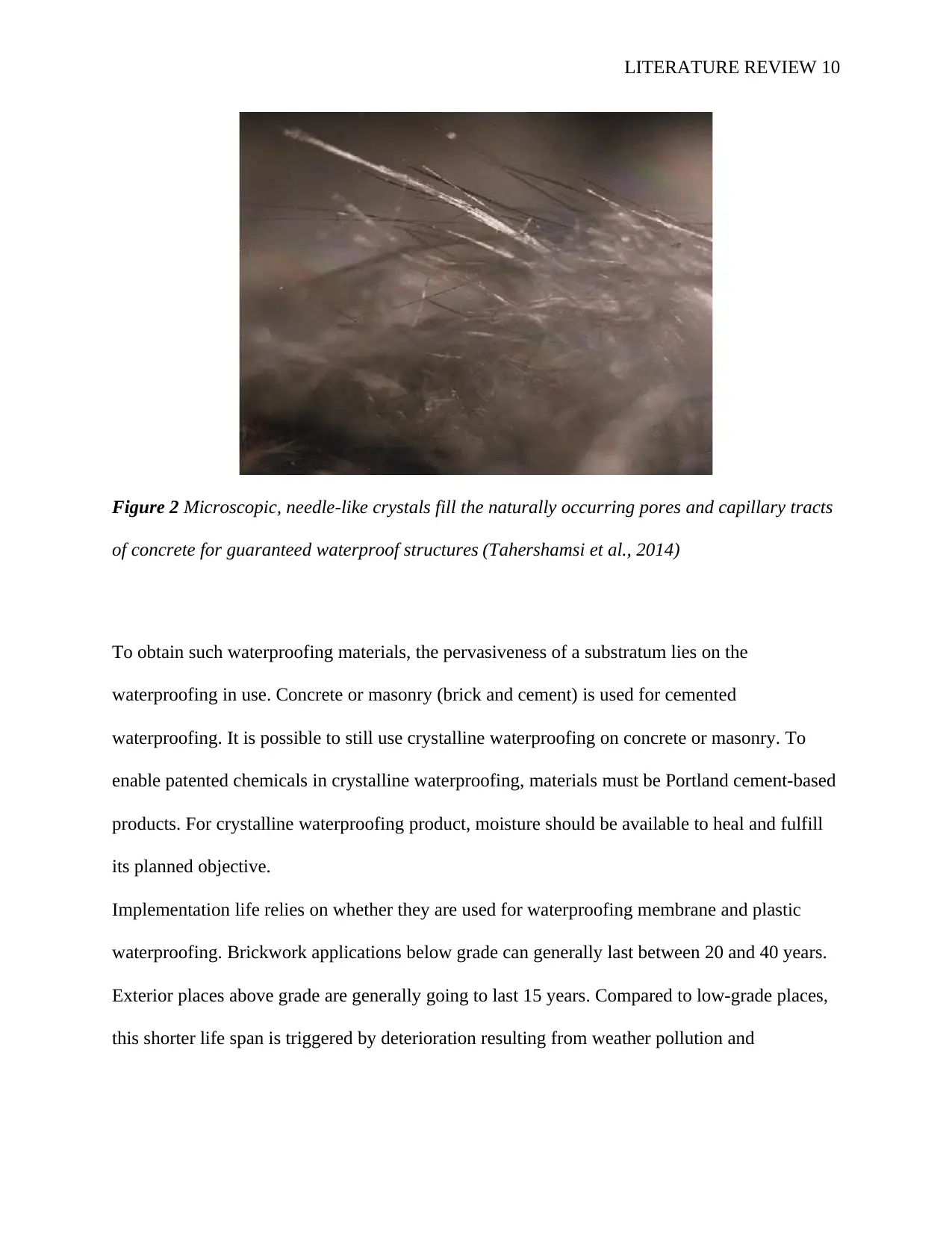
LITERATURE REVIEW 10
Figure 2 Microscopic, needle-like crystals fill the naturally occurring pores and capillary tracts
of concrete for guaranteed waterproof structures (Tahershamsi et al., 2014)
To obtain such waterproofing materials, the pervasiveness of a substratum lies on the
waterproofing in use. Concrete or masonry (brick and cement) is used for cemented
waterproofing. It is possible to still use crystalline waterproofing on concrete or masonry. To
enable patented chemicals in crystalline waterproofing, materials must be Portland cement-based
products. For crystalline waterproofing product, moisture should be available to heal and fulfill
its planned objective.
Implementation life relies on whether they are used for waterproofing membrane and plastic
waterproofing. Brickwork applications below grade can generally last between 20 and 40 years.
Exterior places above grade are generally going to last 15 years. Compared to low-grade places,
this shorter life span is triggered by deterioration resulting from weather pollution and
Figure 2 Microscopic, needle-like crystals fill the naturally occurring pores and capillary tracts
of concrete for guaranteed waterproof structures (Tahershamsi et al., 2014)
To obtain such waterproofing materials, the pervasiveness of a substratum lies on the
waterproofing in use. Concrete or masonry (brick and cement) is used for cemented
waterproofing. It is possible to still use crystalline waterproofing on concrete or masonry. To
enable patented chemicals in crystalline waterproofing, materials must be Portland cement-based
products. For crystalline waterproofing product, moisture should be available to heal and fulfill
its planned objective.
Implementation life relies on whether they are used for waterproofing membrane and plastic
waterproofing. Brickwork applications below grade can generally last between 20 and 40 years.
Exterior places above grade are generally going to last 15 years. Compared to low-grade places,
this shorter life span is triggered by deterioration resulting from weather pollution and
Paraphrase This Document
Need a fresh take? Get an instant paraphrase of this document with our AI Paraphraser

LITERATURE REVIEW 11
environmental pollution. Interior places will normally last 40 years when used as an adverse side
implementation (Crisp, 2012).
The chemical differences between cemented waterproofing products and crystalline
waterproofing products. Cementous waterproofing comprises of cement-based Portland
compounds with proprietary added chemicals that influence healing, endurance, and chemical
strength. Cementitious waterproofing materials are sometimes sold as dry materials for mixing
on the jobsite with water and patented liquid additives and instead applying them to the substrate.
Crystalline waterproofing comprises of cement, quartz or silica sand from Portland and
proprietary chemical products that are blended as powder. On the work site, the dry powder is
mixed with water, then transferred to the substratum. Crystalline waterproofing operates by
sealing concrete pores chemically with existing chemicals to avoid the entry of liquid water
(Gökçe and Şimşek, 2013).
Advantages of Proper Selection of Waterproofing Material
A correctly positioned waterproofing material does have the preceding advantages: it counters
intense hydrostatic pressure from the positive or negative surface of the concrete slab ; it can be
an essential component of the substrate ; it is highly resistant to harmful chemicals ; it penetrates
profoundly and coats the capillary compartments and shrinkage holes of concrete ; waterproofing
and chemical resistance characteristics remain intact even when it has been used. (Crisp, 2012)
environmental pollution. Interior places will normally last 40 years when used as an adverse side
implementation (Crisp, 2012).
The chemical differences between cemented waterproofing products and crystalline
waterproofing products. Cementous waterproofing comprises of cement-based Portland
compounds with proprietary added chemicals that influence healing, endurance, and chemical
strength. Cementitious waterproofing materials are sometimes sold as dry materials for mixing
on the jobsite with water and patented liquid additives and instead applying them to the substrate.
Crystalline waterproofing comprises of cement, quartz or silica sand from Portland and
proprietary chemical products that are blended as powder. On the work site, the dry powder is
mixed with water, then transferred to the substratum. Crystalline waterproofing operates by
sealing concrete pores chemically with existing chemicals to avoid the entry of liquid water
(Gökçe and Şimşek, 2013).
Advantages of Proper Selection of Waterproofing Material
A correctly positioned waterproofing material does have the preceding advantages: it counters
intense hydrostatic pressure from the positive or negative surface of the concrete slab ; it can be
an essential component of the substrate ; it is highly resistant to harmful chemicals ; it penetrates
profoundly and coats the capillary compartments and shrinkage holes of concrete ; waterproofing
and chemical resistance characteristics remain intact even when it has been used. (Crisp, 2012)
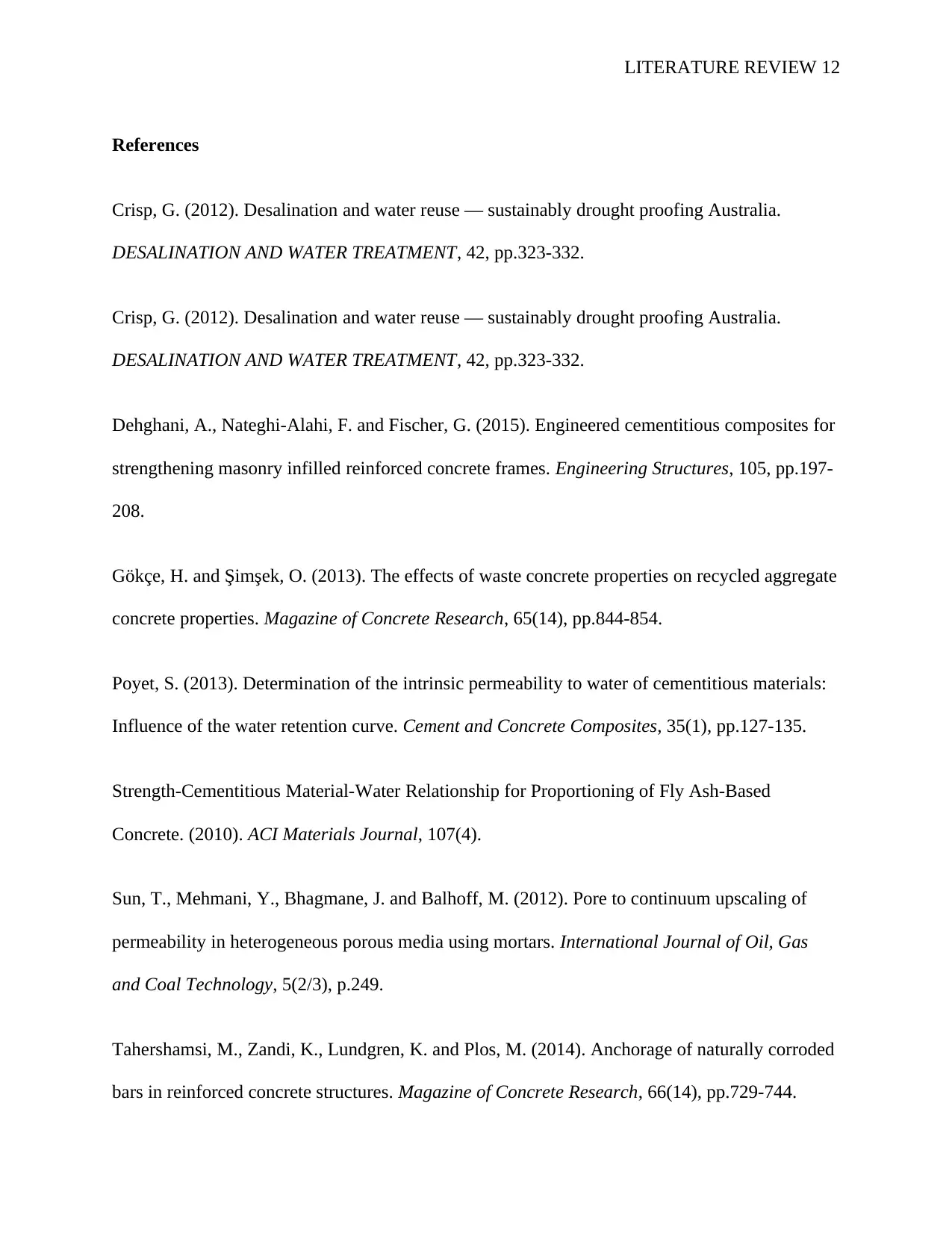
LITERATURE REVIEW 12
References
Crisp, G. (2012). Desalination and water reuse — sustainably drought proofing Australia.
DESALINATION AND WATER TREATMENT, 42, pp.323-332.
Crisp, G. (2012). Desalination and water reuse — sustainably drought proofing Australia.
DESALINATION AND WATER TREATMENT, 42, pp.323-332.
Dehghani, A., Nateghi-Alahi, F. and Fischer, G. (2015). Engineered cementitious composites for
strengthening masonry infilled reinforced concrete frames. Engineering Structures, 105, pp.197-
208.
Gökçe, H. and Şimşek, O. (2013). The effects of waste concrete properties on recycled aggregate
concrete properties. Magazine of Concrete Research, 65(14), pp.844-854.
Poyet, S. (2013). Determination of the intrinsic permeability to water of cementitious materials:
Influence of the water retention curve. Cement and Concrete Composites, 35(1), pp.127-135.
Strength-Cementitious Material-Water Relationship for Proportioning of Fly Ash-Based
Concrete. (2010). ACI Materials Journal, 107(4).
Sun, T., Mehmani, Y., Bhagmane, J. and Balhoff, M. (2012). Pore to continuum upscaling of
permeability in heterogeneous porous media using mortars. International Journal of Oil, Gas
and Coal Technology, 5(2/3), p.249.
Tahershamsi, M., Zandi, K., Lundgren, K. and Plos, M. (2014). Anchorage of naturally corroded
bars in reinforced concrete structures. Magazine of Concrete Research, 66(14), pp.729-744.
References
Crisp, G. (2012). Desalination and water reuse — sustainably drought proofing Australia.
DESALINATION AND WATER TREATMENT, 42, pp.323-332.
Crisp, G. (2012). Desalination and water reuse — sustainably drought proofing Australia.
DESALINATION AND WATER TREATMENT, 42, pp.323-332.
Dehghani, A., Nateghi-Alahi, F. and Fischer, G. (2015). Engineered cementitious composites for
strengthening masonry infilled reinforced concrete frames. Engineering Structures, 105, pp.197-
208.
Gökçe, H. and Şimşek, O. (2013). The effects of waste concrete properties on recycled aggregate
concrete properties. Magazine of Concrete Research, 65(14), pp.844-854.
Poyet, S. (2013). Determination of the intrinsic permeability to water of cementitious materials:
Influence of the water retention curve. Cement and Concrete Composites, 35(1), pp.127-135.
Strength-Cementitious Material-Water Relationship for Proportioning of Fly Ash-Based
Concrete. (2010). ACI Materials Journal, 107(4).
Sun, T., Mehmani, Y., Bhagmane, J. and Balhoff, M. (2012). Pore to continuum upscaling of
permeability in heterogeneous porous media using mortars. International Journal of Oil, Gas
and Coal Technology, 5(2/3), p.249.
Tahershamsi, M., Zandi, K., Lundgren, K. and Plos, M. (2014). Anchorage of naturally corroded
bars in reinforced concrete structures. Magazine of Concrete Research, 66(14), pp.729-744.
⊘ This is a preview!⊘
Do you want full access?
Subscribe today to unlock all pages.

Trusted by 1+ million students worldwide
1 out of 12
Your All-in-One AI-Powered Toolkit for Academic Success.
+13062052269
info@desklib.com
Available 24*7 on WhatsApp / Email
![[object Object]](/_next/static/media/star-bottom.7253800d.svg)
Unlock your academic potential
Copyright © 2020–2025 A2Z Services. All Rights Reserved. Developed and managed by ZUCOL.